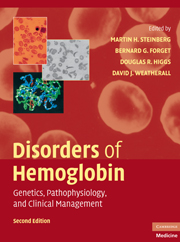Book contents
- Frontmatter
- Contents
- List of Contributors
- Foreword, by H. Franklin Bunn
- Preface
- Introduction, by David J. Weatherall
- SECTION ONE THE MOLECULAR, CELLULAR, AND GENETIC BASIS OF HEMOGLOBIN DISORDERS
- SECTION TWO PATHOPHYSIOLOGY OF HEMOGLOBIN AND ITS DISORDERS
- SECTION THREE α THALASSEMIA
- 13 The Molecular Basis of α Thalassemia
- 14 The Pathophysiology and Clinical Features of α Thalassaemia
- 15 Unusual Types of α Thalassemia
- SECTION FOUR THE β THALASSEMIAS
- SECTION FIVE SICKLE CELL DISEASE
- SECTION SIX OTHER CLINICALLY IMPORTANT DISORDERS OF HEMOGLOBIN
- SECTION SEVEN SPECIAL TOPICS IN HEMOGLOBINOPATHIES
- SECTION EIGHT NEW APPROACHES TO THE TREATMENT OF HEMOGLOBINOPATHIES AND THALASSEMIA
- Index
- Plate section
- References
13 - The Molecular Basis of α Thalassemia
from SECTION THREE - α THALASSEMIA
Published online by Cambridge University Press: 03 May 2010
- Frontmatter
- Contents
- List of Contributors
- Foreword, by H. Franklin Bunn
- Preface
- Introduction, by David J. Weatherall
- SECTION ONE THE MOLECULAR, CELLULAR, AND GENETIC BASIS OF HEMOGLOBIN DISORDERS
- SECTION TWO PATHOPHYSIOLOGY OF HEMOGLOBIN AND ITS DISORDERS
- SECTION THREE α THALASSEMIA
- 13 The Molecular Basis of α Thalassemia
- 14 The Pathophysiology and Clinical Features of α Thalassaemia
- 15 Unusual Types of α Thalassemia
- SECTION FOUR THE β THALASSEMIAS
- SECTION FIVE SICKLE CELL DISEASE
- SECTION SIX OTHER CLINICALLY IMPORTANT DISORDERS OF HEMOGLOBIN
- SECTION SEVEN SPECIAL TOPICS IN HEMOGLOBINOPATHIES
- SECTION EIGHT NEW APPROACHES TO THE TREATMENT OF HEMOGLOBINOPATHIES AND THALASSEMIA
- Index
- Plate section
- References
Summary
INTRODUCTION
Before describing the various ways in which α-globin expression may be downregulated in patients with α thalassemia, it is worth briefly reviewing the normal structure of the human α-globin cluster and how the genes are expressed throughout erythroid differentiation and development.
The α-globin cluster is located in a gene dense region of the genome close to the telomere of chromosome 16 (16p13.3). The genes are arranged along the chromosome in the order, telomere-ς-ψς-αD-ψα1-α2-α1-θ-centromere (Fig. 13.1). Upstream of the α cluster there are four highly conserved, noncoding sequences multispecies conserved sequences called MCS-R1–R4 that are thought to be important in the regulation of the α-like globin genes. They correspond to previously identified erythroid-specific DNase l hypersensitive sites (DHS) referred to as HS-48, HS-40, HS-33, and HS-10, the coordinates referring to their positions (kb) with respect to the ς-globin mRNA cap site. Of these elements, only MCS-R2 (HS-40) has been shown to be essential for α globin expression (summarized in Higgs et al.). The role(s) of the other MCS sequences are as yet unclear.
It has been shown that as progenitors commit to the erythroid lineage and differentiate to form mature red cells, a subset of the key erythroid transcription factors and cofactors (Chapter 4) progressively bind the upstream elements and the promoters of the α-like globin genes. Finally, RNA polymerase II is recruited to both the upstream regions and the globin promoters as transcription starts in early and intermediate erythroblasts.
- Type
- Chapter
- Information
- Disorders of HemoglobinGenetics, Pathophysiology, and Clinical Management, pp. 241 - 265Publisher: Cambridge University PressPrint publication year: 2009
References
- 1
- Cited by

